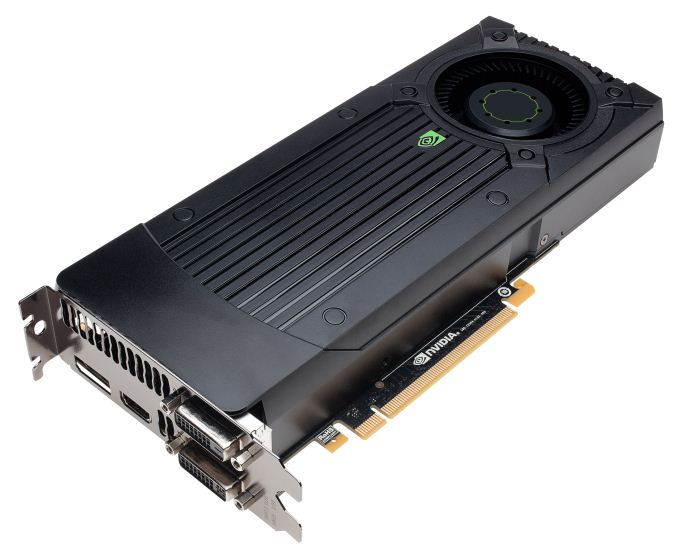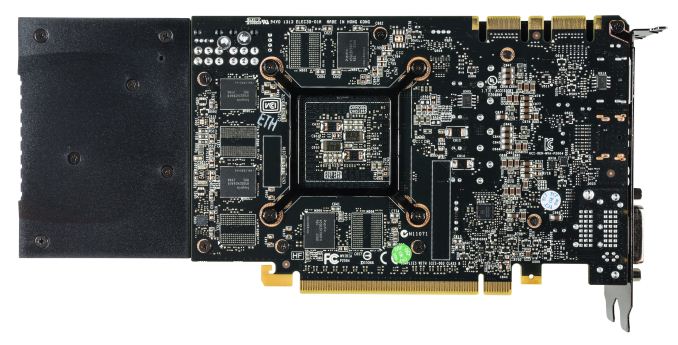NVIDIA GeForce GTX 760 Review: The New Enthusiast Kepler
by Ryan Smith on June 25, 2013 9:00 AM ESTMeet the GeForce GTX 760
As we mentioned earlier, due to its 170W TDP the GTX 760 is essentially a drop-in replacement for the GTX 670 in board designs. Even NVIDIA’s reference design reflects this, with the reference GTX 760 being based on the reference GTX 670’s cooler and PCB. Consequently there’s not much to say about the GTX 760’s design that we haven’t said before. If you’ve seen a GTX 670 then you’ve seen a GTX 760, down to the last screw. For consistency we’ll quickly go over the GTX 760’s design, but this is generally a rehash of what we’ve already said about the GTX 670.
Like GTX 670 before it, GTX 760 is another “small” GK104 design. The complete card is 9.5” long, however the actual PCB is far shorter at only 6.75” long, 3.75” shorter than the GTX 770’s PCB. In fact it would be fair to say that rather than strapping a cooler onto a card, NVIDIA strapped a card onto a cooler. Meanwhile we see that once again NVIDIA is using Hynix R0C (6GHz) GDDR5 RAM here.
The cooler itself is fairly simple, utilizing an aluminum heatsink melded with a copper base plate. A separate heatsink covers the VRM circuitry – once again mounted at the front of the card – while the fan hangs off of the rear of the card. This unfortunately is the same fan as on the GTX 670, which means it makes a faint grinding sound at low RPMs. This design has proven more than adequate for the GTX 670s, though it does leave some room for NVIDIA’s partners to improve on overall cooling performance, especially with open air coolers.
Elsewhere at the top of the card we’ll find the PCIe power sockets and SLI connectors. Two 6-pin PCIe sockets provide the necessary external power, while a pair of SLI bridge connectors at the other end allow for up to 3-way SLI. NVIDIA’s standard I/O configuration also makes an appearance here, offering 2x DL-DVI, 1x HDMI, 1x DisplayPort 1.2.
Looking at clockspeed bins for a moment, it comes as no great surprise that like the GTX 770, the GTX 760 operates at 1.2v at its highest stock clockspeed bin. The higher voltage versus the 1.76v limit on the 600 series causes power consumption to jump up more rapidly at the highest bins, but is necessary to unlock the 1100MHz+ clockspeeds the card is capable of.
| GeForce Clockspeed Bins | ||||
| Clockspeed | GTX 770 | GTX 760 | ||
| 1162MHz | N/A | 1.212v | ||
| 1149MHz | 1.212v | 1.2v | ||
| 1136MHz | 1.2v | 1.187v | ||
| 1123MHz | 1.187v | 1.162v | ||
| 1110MHz | 1.162v | 1.15v | ||
| 1097MHz | 1.15v | 1.137v | ||
| 1084MHz | 1.137v | 1.125v | ||
| 1071MHz | 1.125v | 1.112v | ||
| 1058MHz | 1.112v | 1.1v | ||
| 1045MHz | 1.1v | 1.087v | ||
Finaly, for overclockers there is one further bin (1162MHz) available via overvolting to 1.212v. The maximum power target meanwhile is 115%, for a final power limit of 195W.
















110 Comments
View All Comments
Ryan Smith - Tuesday, June 25, 2013 - link
Going by my chart, I have the GTX 760 winning in 7 of 10 games (all but DiRT, Hitman, and Crysis 1) at our highest 1080p quality settings, which is where I'm focusing on for a card this expensive. Of those magnitude matters; most of those GTX 760 wins are in the double digits, so the average does indeed end up being 8%As for frametimes, the idea is that we would normally include them. That said this review left us crunched for time; I would have likely needed to drop the Fermi cards to make time. With that in mind, there's absolutely nothing interesting going on with single-GPU frametimes right now with the games we use. The only place NVIDIA still differ are under multi-GPU scenarios.
Zstream - Tuesday, June 25, 2013 - link
Shouldn't we be using the median instead of average?ewood - Tuesday, June 25, 2013 - link
median, mean and mode all show very different things. you should have all three to draw detailed conclusions, however if only one is available i would personally prefer it be the mean.ShieTar - Thursday, June 27, 2013 - link
With a sample size of 10, the median would not be a very helpful information. To be honest, the mean is not all the important either. The distribution of performances is not all that random when comparing nVidia and AMD, but rather there are significant preferences for one architecture by each game.So everybody on the lookout for a new card should mainly be checking for a benchmark specifically on the game he/she spends the most time with. For this reason, I would love to see the benchmarks on Anandtech include the name of the engine for each game (if it is a licensed one), and maybe provide some handy reference to figure out what other games use the same reference.
And personally, as a player who does not play reaction-based games like shooters or racers a lot, I would love AT to re-introduce a BioWare and/or Blizzard title back into their benchmark-zoo. Even if those are not extremely new or demanding, I think they still have a high importance for a large number of players who don't care much to shoot virtual people in their virtual faces.
MarcVenice - Tuesday, June 25, 2013 - link
I see, I counted Sleeping Dogs as a win for the HD 7950 as well, considering the minimum fps is a bit higher. Thanks for the reply, I agree that if all is well with frametimes in a certain game, fraps is still a good way to measure raw rendering power.JeBarr - Tuesday, June 25, 2013 - link
Most multi-GPU users are reporting that the frame time issue mostly exists for 2-way SLI and Quad SLI. It seems that 3-way SLI or Dual GPU single slot SLI is the way to go for gamers concerned about the stutters. I'm not sure about 4-way SLI though, since I don't bother with it anymore. I can however, confirm that in my personal experience a single GPU or 3-way SLI is mostly unaffected.draknon - Tuesday, June 25, 2013 - link
This seems like a good spot to upgrade from my 460gtxEzioAs - Tuesday, June 25, 2013 - link
Yeah, it is. My original plan was to get the GTX 760, but Nvidia delayed it and I wasn't going to wait anymore, so I went and bought the GTX 660.DanNeely - Tuesday, June 25, 2013 - link
I'm tempted to upgrade to it from my 560 when I built a Haswell box later this summer and put the difference between it and a higher end card toward a better SSD, etc and then get a top end Maxwell based card next year.I'm a bit concerned about ending up in the same trap I did last time though. I bought the 560 as a stopgap replacement in Jan 2012 after stupidity killed my 5870, with the intent of upgrading to a GK100 based card in half a year or so only to have nVidia fumble its top end launch.
omarccx - Tuesday, June 25, 2013 - link
It seems like an even greater upgrade from my HD4000. :x